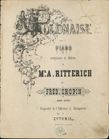



PE - First Polish Edition
| Publisher: | J. Chrząszcz |
| Date: | ok. 1853 |
| Title: | Polonaise |
| Dedication: | Mr. A. Ritterich |
A significant number of changes visible when comparing PE with the remaining sources allows to, at first sight, assume that it is based on a different copy of the piece. At the same time, the analysis of the notation of PE reveals numerous features characteristic for Chopin notation and particularly from the Warsaw period, during which the Polonaise was created. The features include:
-
use of the willingly applied by Chopin
 indication instead of the more common
indication instead of the more common  (e.g., in bars 24 and 30-31);
(e.g., in bars 24 and 30-31); - application of two types of staccato signs (dots and wedges), including dots under a slur to indicate the portato articulation (e.g., in bars 8-10, 16, 58-59, 81-82);
- use of three types of accents (short, long, and vertical);
-
presence of

 signs with the written out cres. (the abbreviation used by Chopin!) and dim. (bar 19 and 66), a very characteristic combination for Chopin notation;
signs with the written out cres. (the abbreviation used by Chopin!) and dim. (bar 19 and 66), a very characteristic combination for Chopin notation; - erroneous, yet compatible with the typical Chopin notation, recreation of the tie sustaining a1 in bars 77-78 in such a way, as if it concerned the lower voice;
- abundant use of verbal indications, totally corresponding to the repertoire of indications of young Chopin; particularly the use of the Italian adverb with the "mente" suffix – tranquillamente in bar 9 – Chopin used this form few times only in the pieces from the Warsaw period.
The list presented above empowers us to declare that the base text for PE was a diligently prepared manuscript, most probably an autograph, which we mark as [A]. The autograph was most probably offered as a souvenir, which is indicated by the abundance of precise performance markings, characteristic for many Chopin autographs of such kind (e.g., the Polonaise in F minor WN 12). In comparison to the version of [AI], it includes a number of evident improvements:
-
pitch and rhythmic text – changes in entire bar 3, addition of g
 1 at the end of bar 20, changes in the inner voices in bars 57-58, change of the bass note from C into D
1 at the end of bar 20, changes in the inner voices in bars 57-58, change of the bass note from C into D in bar 74, change of the rhythm of the bass melody in bars 82-84;
in bar 74, change of the rhythm of the bass melody in bars 82-84; - performance markings – the indication sempre tranquillamente and the articulation indications of the repeated notes in bars 8-10, numerous and varied performance hints in bars 68-87, including, e.g., the echo effect in bars 68-69, 72-73, and 76-77;
- improvement and simplification of the notation in the L.H. in bars 9-10 and similar, including particularly bars 25-30;
-
chromatic orthography correction – change of d
 1 into c
1 into c 1 at the end of bar 58.
1 at the end of bar 58.
In PE, a number of mechanical errors was made, e.g., an erroneous accidental in bars 16 and 76, Terzverschreibung errors and others in bars 12, 15, 16, 65, oversights of various elements of the notation in bars 14-15 (slur), 19 ( ), 23 (arpeggio). A serious mistake was also committed probably in bar 22, by inserting a rest instead of a note. There are also minor errors as, e.g., mirroring signs:
), 23 (arpeggio). A serious mistake was also committed probably in bar 22, by inserting a rest instead of a note. There are also minor errors as, e.g., mirroring signs:  before b1 in bar 15 and before e4 in bar 80, the "S" letter in the indication D.S. in bar 37. Such type of errors, more evidently influencing the reading of the text, are probably also featured in bars 33 and 65 (reversed dynamic signs or accents).
before b1 in bar 15 and before e4 in bar 80, the "S" letter in the indication D.S. in bar 37. Such type of errors, more evidently influencing the reading of the text, are probably also featured in bars 33 and 65 (reversed dynamic signs or accents).
We consider PE to be the main text of the Polonaise in B major.
major.
| Original in: | The Fryderyk Chopin Institute Library, Warsaw |
| Shelf-mark: | 1113/n |

